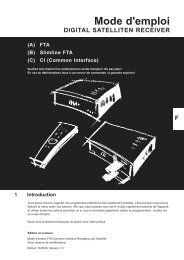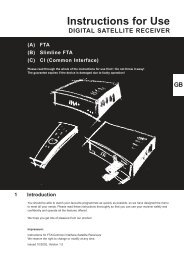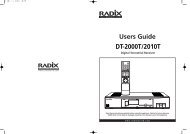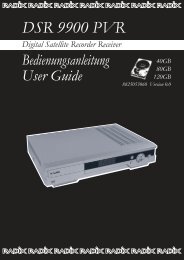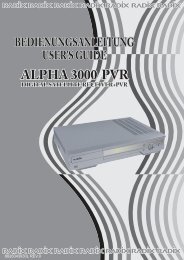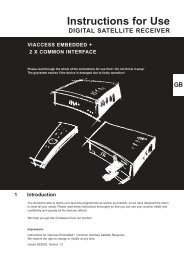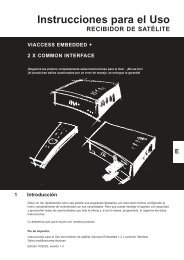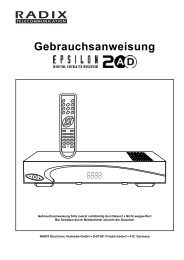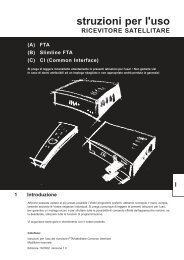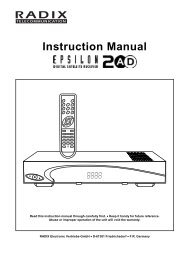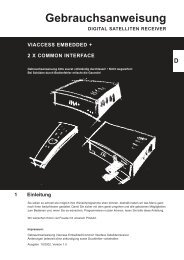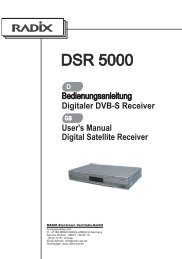gebrauchsanweisung user manual mode d`emploi istruzioni ... - Radix
gebrauchsanweisung user manual mode d`emploi istruzioni ... - Radix
gebrauchsanweisung user manual mode d`emploi istruzioni ... - Radix
Create successful ePaper yourself
Turn your PDF publications into a flip-book with our unique Google optimized e-Paper software.
PROGRAMMIERUNG<br />
D<br />
Ihr Satellitenreceiver ist werkseitig so vorprogrammiert, daß Sie, durch Verwendung von<br />
handelsüblichen Universal-LNBs und DiSEqC-Schaltern (bei gleichzeitigem Empfang<br />
beider SAT-Systeme), die Hauptsatelliten in Europa, ASTRA bei 19° Ost und<br />
EUTELSAT/HOTBIRD bei 13° Ost, empfangen können.<br />
Sollten Sie andere LNBs verwenden, eine andere Anlagenkonfiguration besitzen oder<br />
andere Satelliten empfangen wollen, muß der Receiver an diese Situation angepaßt<br />
werden. Ihr Receiver bietet Ihnen dazu die Möglichkeit, alle Einstellparameter komfortabel<br />
über Bildschirmmenü zu programmieren.<br />
Grundeinstellungen<br />
Receiver ausschalten (Standby) und danach die Kanal-Auf/Ab-Tasten F3/F2 am Receiver<br />
gleichzeitig für ca. 3 Sekunden gedrückt halten, bis am TV-Bildschirm folgende Menütafel<br />
1 erscheint:<br />
Mit den Tasten CH↑ und CH↓ R3/R5 können Sie den Cursor (Hand) auf die gewünschte<br />
Zeile bewegen, durch Drücken der Tasten → oder ← R4/R6 wird die gewünschte<br />
Einstellung vorgenommen.<br />
1. Wählen Sie die gewünschte Menü-Sprache.<br />
2. Wählen Sie die richtige LNB-Lo-Frequenz 9,75 / 10,0 / 10,6 GHz (siehe technische<br />
Daten LNB).<br />
3. Hiermit erfolgt die Feinabstimmung an den LNB im Bereich ±15 MHz in 0,25 MHz-<br />
Schritten pro Tastendruck.<br />
4. Wenn Sie die SMATV-Funktion des DiSEqC-Systems verwenden wollen, ist es<br />
erforderlich, SMATV auf “EIN” zu stellen.<br />
Um die vorgenommenen Einstellungen zu speichern, drücken Sie nun die Taste STORE<br />
R8. Der Receiver schaltet automatisch in den Bereitschafts-Modus (Standby) zurück.<br />
Sollten die Einstellungen nicht gespeichert werden, drücken Sie die MENU-Taste R7.<br />
Programmeinstellungen<br />
Drücken Sie bei eingeschaltetem Receiver die MENU-Taste R7, um die Menü-Tafel 2 aufzurufen:<br />
Mit den Tasten CH↑ und CH↓ R3/R5 können Sie den Cursor (Hand) auf die gewünschte<br />
Zeile bewegen, durch Drücken der Tasten → oder ← R4/R6 wird die gewünschte<br />
Einstellung vorgenommen.<br />
Wenn sich der Cursor in der ersten Zeile befindet, können Sie mit der CH↑ Taste R3 zur<br />
4. Menü-Tafel (DiSEqC-Einstellungen) wechseln.<br />
1. Wählen Sie den gewünschten Programmplatz durch Drücken der Tasten → oder ←<br />
R4/R6, oder durch direkte Eingabe der dreistelligen Programmnummer über das<br />
Ziffernfeld R2.<br />
2. Schreiben Sie den gewünschten Programmnamen: Wählen Sie mit der Taste → oder<br />
← R4/R6 die gewünschte Position (blinkt) und selektieren Sie mit den Tasten CH↑<br />
und CH↓ R3/R5 den gewünschten Buchstaben (Zahl, Sonderzeichen). Durch<br />
wiederholtes Drücken der Taste → oder ← R4/R6 können Sie diesen Menüpunkt<br />
verlassen.<br />
3. Wählen Sie die erforderliche Video-Frequenz durch Drücken der Tasten → oder ←<br />
R4/R6, oder durch direkte Eingabe über das Ziffernfeld R2.<br />
4. Wählen Sie die erforderliche Polarisationsebene.<br />
5. Schalten Sie die 22 kHz ein bzw. aus (AUS=Unteres Band, EIN=Oberes Band).<br />
Wenn sich der Cursor in der letzten Zeile befindet, können Sie mit der CH↓Taste R5 zur<br />
3. Menü-Tafel für die Audio-Einstellungen wechseln.<br />
SYSTEM MENU<br />
SPRACHE : DEUTSCH<br />
LNB FREQ. : 9.75GHZ<br />
GLOB.VERS : 00.00MHZ<br />
SMATV : AUS<br />
MENÜTAFEL 1<br />
SYSTEMMENÜ<br />
10<br />
PROGRAMMING THE RECEIVER<br />
Your satellite receiver has been factory preprogrammed such that you may use standard,<br />
commercially available, universal LNB’s and DiSEqC-switches (if you plan to receive<br />
video transmissions from both satellites simultaneously) to receive broadcasts from the<br />
two major European television satellites, ASTRA at 19° East and EUTELSAT/HOTBIRD at<br />
13° East.<br />
The receiver will have to be reprogrammed if you intend to employ some other type of<br />
LNB, are using some other system configuration, or would like to receive broadcasts from<br />
other television satellites. Your receiver allows you to conveniently reset all <strong>user</strong>adjustable<br />
reception parameters from an onscreen menu..<br />
Basic Settings<br />
Switch the receiver off (standby <strong>mode</strong>) and then press both of the channel<br />
increment/decrement keys F3/F2 on the receiver and hold both of them depressed for<br />
about three seconds until the following menu (Onscreen Display Page 1) appears on the<br />
TV-screen:<br />
Use the CH↑ and CH↓ keys R3/R5 to position the cursor (stylized hand) on the desired<br />
display lines in turn and then use the → and ← keys R4/R6 to make the desired<br />
settings.<br />
1. Select the language to be employed on onscreen menus.<br />
2. Select the correct LNB-Lo-frequency (9.75/10.0/10.6 GHz; cf. the technical data for<br />
the LNB employed).<br />
3. Use these keys to fine-tune the LNB over a range of ± 15 MHz in 0.25-MHz<br />
increments per key press.<br />
4. If you intend to use the SMATV-function of the DiSEqC-system, set SMATV to ”ON.”.<br />
Press the STORE-key R8 to save the settings made. The receiver will then automatically<br />
return to standby <strong>mode</strong>. Press the MENU-key R7 to abort the settings made.<br />
Channel Settings<br />
GB<br />
While the receiver is on, press the MENU-key R7 to call up the menu of Onscreen Display<br />
Page 2:<br />
Use the CH↑ and CH↓ keys R3/R5 to position the cursor (stylized hand) on the desired<br />
display lines in turn and use the → and ← keys R4/R6 to make the desired settings.<br />
Position the cursor on the top display line and press the CH↑ key R3 to switch to the<br />
menu of Onscreen Display Page 4 (DiSEqC-settings).<br />
1. Use the → or ← keys R4/R6 to select the desired TV-station, or use the<br />
keys of the numerical keypad R2 to enter its three-digit numerical code.<br />
2. Enter a name for the TV-station. Use the → or ← keys R4/R6 to select the desired<br />
(blinking) position and then use the CH↑ and CH↓ keys R3/R5 to select the desired<br />
characters (letters, numerals, or special characters). Repeatedly press the → or ←key<br />
R4/R6 to exit this menu item.<br />
3. Select the video frequency required using the → or ←keys R4/R6, or use the keys of<br />
the numerical keypad R2 to enter the video frequency.<br />
4. Select the required orientation of the plane of polarization.<br />
5. Switch the 22-kHz local oscillator ON/OFF (OFF = the lower band, ON = the upper<br />
band).<br />
Position the cursor on the bottom display line and press the CH↓ key R5 to switch to the<br />
menu of Onscreen Display Page 3 for making the audio settings.




